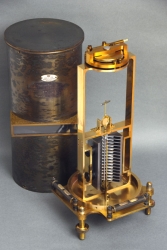Scientific Instrument Society 25th Anniversary Exhibition
Navigation:
<< First | < Previous | Next > | Last >>
24 Kelvin Multi-Cellular Electrostatic Voltmeter
This instrument was purchased in December 1996 at Christies South Kensington in competition with an American dealer, who fortunately dropped out of the bidding when he realised how much it would cost to ship the instrument safely back to the States. Although this instrument originally came from the Board of Trade Standards Laboratory (as evidenced by its ivorine label), its later history clearly involved a fall from grace, as it was apparently brought into Christies by a scrap metal dealer!
Smaller forms of Kelvin’s multicellular voltmeter are surprisingly common, but this large example is the only standard instrument that I have come across. The multicellular voltmeter was introduced in 1887 by the famous mathematical physicist William Thomson, 1st Baron Kelvin (1824-1907) to meet a demand from the then growing electrical supply industry for instruments capable of measuring high voltages (it is capable of measuring up to 20,000 volts). It could be used in both direct and alternating current circuits, and because it is electrostatic, does not use any current, unlike moving iron instruments. This example is signed ‘>Lord Kelvin’s Patents, Multicellular Volt Meter No. 804, James White, Glasgow’ and dates from about 1895.
An interesting engraving appears in The Book of Electrical Installations by Rankin Kennedy and dating from around 1910. It shows a bank of six standard multi-cellular voltmeters, mounted on a platform, with six sighting wire telescopes. Quite why as many as six such instruments would be required in this configuration is a bit of a mystery, as a standardising instrument might be expected to have been used singly. Perhaps they were employed on different circuits, or an average reading was being taken.
Private Collection, London
See: Kelvin: Mathematical and Physical Papers. Vol V, p. 488, p. 533.
British Patent Specification No.18035, Dec 1888, Electrostatic Apparatus for Measuring Potentials.
Rankin Kennedy: The Book of Electrical Installations, Caxton Publishing Company, circa 1910.
Objects lent by Anonymous Lender III, London:

